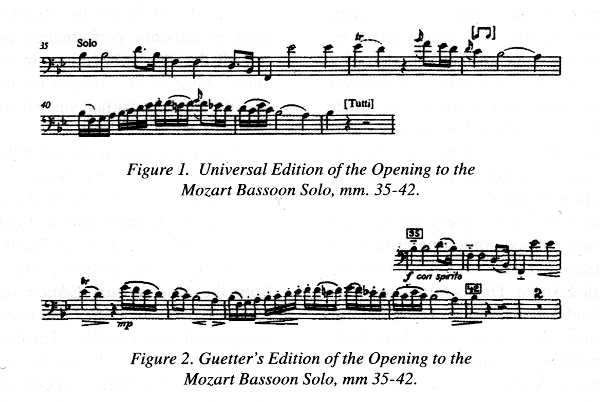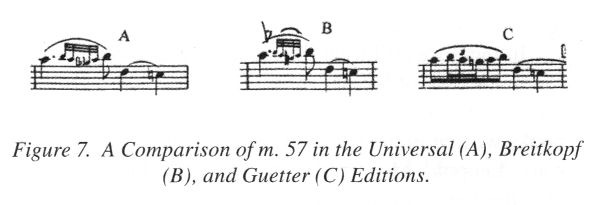<Music: Vincent Igusa, bassoon, and Catherine Renggli, piano. Towson University Recital Hall, 20 June 2017.>
1. Welcome, I am Terry Ewell, the Bassoon Digital Professor. I am quite excited to bring this new series to you about the Mozart Bassoon Concerto.
2. The first movement of the Mozart Bassoon Concerto is perhaps the most significant work in the repertoire for bassoonists. I have performed the Concerto many times, including with the Hong Kong Philharmonic under the direction of Maestro Jah Jah Ling.
3. The first movement of the Concerto is required for many university auditions. It is a staple of orchestral auditions as well. Last of all, the accessibility and beauty of the Concerto has made it a favorite with performers and audiences for many years.
4. Thus, given the significance of the work, you should carefully research all features of the Concerto. My goal with these videos is to educate you about neglected and perhaps even unknown aspects of this prized possession in our repertoire.
5. There are numerous editions of the Mozart Concerto available. I own seven print editions of the work. You might be thinking, are the editions really all that different? Well, let’s take a look. I have performed from the edition in Figure 1 for several decades. The version in Figure 2 was perhaps the most common edition of the Concerto in 20th century USA.

7. Let’s make another comparison in the Concerto.

8. Thus, you can see that
your choice of music will determine the manner in which you play and
even the particular notes you perform in the concerto. The Guetter
edition writes out the turn, and it appears quite different than the
other versions. The turns in Examples B and C give B natural. These
sound “correct” because of the many performances of
the work you may have heard. However, the turn with B flat would be
quite common for the performance practice in Mozart’s time.
The editor in version A, the Universal Edition, indicates this. Only by
referring to the Universal edition or another edition more closely
aligned with the original version would you know about playing a B flat
here.
<Music: performance of mm. 50-57>
9. There are many more differences between the editions and you should consider them carefully.
10. These are my recommendations for performance editions:
11. Not all of the editions above are without errors. For instance, the second movement of the Universal edition of the bassoon part has missing rests in measures 1 and 2. [show figure] In all cases, I suggest you check your version of the music with the free, authoritative edition of the work.
12. Log onto the NMA publications website and type in “191” in the appropriate box. 191 is the KV number for the bassoon concerto.
http://dme.mozarteum.at/DME/nma/nmapub_srch.php?l=2
13. There is no excuse, there is no excuse, there is no excuse for any bassoonist to be playing the Concerto without knowledge of the best edition of the work. This edition is available without charge to anyone with access to the Internet.
14. Here are three articles that will further guide your study of the concerto:
15. I am very grateful for the assistance of my student Vincent Igusa and pianist Catherine Renggli, who perform this composition for the videos in this series. Last year, Vincent performed the first movement of the Concerto with the Baltimore Symphony Orchestra. He was a sophomore in High School at the time.
16. It is my hope that this series will awaken in you a new appreciation for the Concerto and enlighten your understanding of this wonderful composition.
<Music: Vincent Igusa, bassoon, and Catherine Renggli, piano. Towson University Recital Hall, 20 June 2017.>
<Music: performance of mm. 50-57>
9. There are many more differences between the editions and you should consider them carefully.
10. These are my recommendations for performance editions:
Concerto in Bb Major K191
(Turkovic)-BSN/PN
Composer: Mozart, Wolfgang Amadeus
Publisher: Universal Edition (Austria)
Edition: 18123
Concerto in Bb Major K191 (Urtext) (Study Score)-BSN/ORCH
Composer: Mozart, Wolfgang Amadeus
Publisher: Barenreiter (Germany)
Edition: TP253
Concerto in Bb Major K191 (Urtext)-BSN/PN
Composer: Mozart, Wolfgang Amadeus
Publisher: Barenreiter (Germany)
Edition: 4868-90
Concerto in Bb Major K191 (Score & Set)-BSN/ORCH
Composer: Mozart, Wolfgang Amadeus
Publisher: Breitkopf und Haertel (Germany)
Edition: 15103set
Composer: Mozart, Wolfgang Amadeus
Publisher: Universal Edition (Austria)
Edition: 18123
Concerto in Bb Major K191 (Urtext) (Study Score)-BSN/ORCH
Composer: Mozart, Wolfgang Amadeus
Publisher: Barenreiter (Germany)
Edition: TP253
Concerto in Bb Major K191 (Urtext)-BSN/PN
Composer: Mozart, Wolfgang Amadeus
Publisher: Barenreiter (Germany)
Edition: 4868-90
Concerto in Bb Major K191 (Score & Set)-BSN/ORCH
Composer: Mozart, Wolfgang Amadeus
Publisher: Breitkopf und Haertel (Germany)
Edition: 15103set
11. Not all of the editions above are without errors. For instance, the second movement of the Universal edition of the bassoon part has missing rests in measures 1 and 2. [show figure] In all cases, I suggest you check your version of the music with the free, authoritative edition of the work.
12. Log onto the NMA publications website and type in “191” in the appropriate box. 191 is the KV number for the bassoon concerto.
http://dme.mozarteum.at/DME/nma/nmapub_srch.php?l=2
13. There is no excuse, there is no excuse, there is no excuse for any bassoonist to be playing the Concerto without knowledge of the best edition of the work. This edition is available without charge to anyone with access to the Internet.
14. Here are three articles that will further guide your study of the concerto:
Ewell,
Terry B. John Miller’s Master Class on the Mozart Bassoon
Concerto K191. The Double Reed 28/1 (Winter 2005): 63-68. http://www.2reed.net/EwellArticles/MilllerMasterClassDR28_1.pdf
Ewell, Terry B. Playing those “Missing” Notes in Baroque and Classical Concerti. The Double Reed 20/1 (1997). http://www.2reed.net/EwellArticles/MissingNotes.html
Ross, David J. “Ornamentation in the Bassoon Music of Vivaldi and Mozart,” Part II. The Double Reed 9/3 (Winter 1986).
Ewell, Terry B. Playing those “Missing” Notes in Baroque and Classical Concerti. The Double Reed 20/1 (1997). http://www.2reed.net/EwellArticles/MissingNotes.html
Ross, David J. “Ornamentation in the Bassoon Music of Vivaldi and Mozart,” Part II. The Double Reed 9/3 (Winter 1986).
15. I am very grateful for the assistance of my student Vincent Igusa and pianist Catherine Renggli, who perform this composition for the videos in this series. Last year, Vincent performed the first movement of the Concerto with the Baltimore Symphony Orchestra. He was a sophomore in High School at the time.
16. It is my hope that this series will awaken in you a new appreciation for the Concerto and enlighten your understanding of this wonderful composition.
<Music: Vincent Igusa, bassoon, and Catherine Renggli, piano. Towson University Recital Hall, 20 June 2017.>
